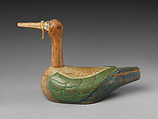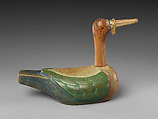Wedding goose
The artisan who made this goose thoughtfully incorporated the wood grain into the surface decoration, both in the unpainted areas and the sections showing through the thin layer of paint. The body is carved from a single piece of wood. From a separate piece the carver made the head and neck, taking advantage of dark spots on either side of the wood to define the eyes. One is a small, dark spot where a twig was once attached and the other is lighter and larger, with an additional semicircular “brow.”
A groom would present a goose—known to mate for life—to a bride’s family as a promise of his devotion and fidelity. During the Joseon period a wood goose was substituted for a live bird. As part of the wedding ceremony, a member of the groom’s entourage would carry the sculpture, its body enveloped in a wrapping cloth, to the bride’s home. The groom, dressed in his official wedding costume, would kneel, place the bird on a table, and bow twice. In recent times a pair of wood ducks has replaced the single goose.
This image cannot be enlarged, viewed at full screen, or downloaded.
This artwork is meant to be viewed from right to left. Scroll left to view more.




